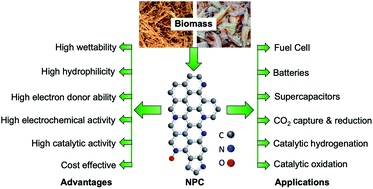Recent progress in the development of biomass-derived nitrogen-doped porous carbon
Abstract
This review offers a focused discussion on the recent progress of biomass-derived nitrogen-doped porous carbon (NPC) and its applications. Various synthesis methods for biomass-derived NPCs are introduced and critically reviewed. N-doping is a promising approach for further improving the physicochemical/electrochemical properties of carbon materials. Besides, NPC synthesis from inexpensive biomass for energy storage applications is a green and sustainable strategy. NPCs can be synthesized directly from algae, chitosan, and glucosamine without using any additional N precursor. The effect of synthesis methods on the physicochemical properties of NPCs offers a direction for optimizing the properties of NPCs for diverse applications. The utilization of NPCs in various applications, including catalysis and electrochemical energy storage (e.g., fuel cells, batteries, and supercapacitors), is reviewed. Besides, a discussion on the use of NPCs in oxidation and hydrogenation reactions, CO2 capture and reduction is provided. The factors controlling the electrocatalytic performance of NPC are evaluated, such as the effect of N-content and the type of N species in NPCs. Finally, to improve the rational design of biomass-derived NPCs for catalysis and energy storage applications, an outlook and conclusion are provided.

- This article is part of the themed collections: Editor’s Choice 2023: Advancing electrocatalysts for a sustainable future. and Journal of Materials Chemistry A Lunar New Year collection 2022


 Please wait while we load your content...
Please wait while we load your content...